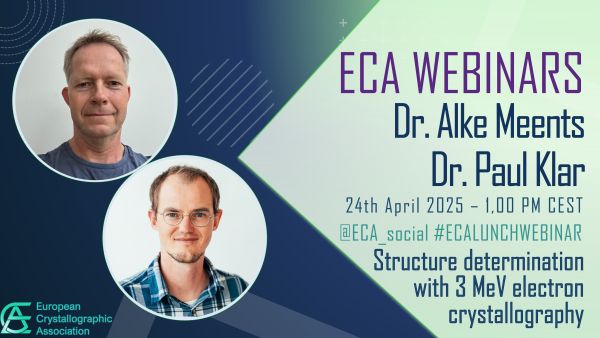L'Association Européenne de Cristallographie (ECA) organise depuis 2021 des "webinaires déjeuner". Les groupes d'intérêt spéciaux (SIG) et les groupes d'intérêt général (GIG) de l'ECA organisent à tour de rôle un webinaire adapté à la communauté des cristallographes au sens large. Le 36ième webinaire sera diffusé le 24 avril 2025 à 13h. Le thème de ce webinaire est Structure determination with 3MeV electron crystallography (Alke Meents et Paul Klar, DESY Hambourg, Université de Brème, Allemagne). Inscriptions ici.
Understanding the atomic structure is fundamental for the development of materials with improved properties. While X-ray methods allow diverse sample environments, they often times lack contrast for light elements and cause significant radiation damage. In contrast, the strong interaction in conventional electron diffraction restricts sample thickness to the nanometer range. We have applied the method of MeV electron diffraction with an electron wavelength of 0.003 Å for ab initio 3D structure determination at atomic resolution. Using ultrashort electron pulses from the REGAE accelerator at DESY (Deutsches Elektronen Synchrotron, Hamburg, Germany), we obtained high-quality diffraction data from muscovite and 1T-TaS₂, enabling the accurate determination of structural details like the displacive modulation of TaS₂ and the hydrogen site in muscovite. The increased penetration depth of MeV electrons allowed for structure determination from samples significantly thicker than those typically applicable in electron diffraction. Sample preparation is a particular challenge for the used setup, since the size of the electron beam of several hundred micrometers requires ‘pancake’-shaped samples with similar lateral dimensions but at the same time a thickness of ideally less than one micrometer. To overcome this limitation, we have implemented a 3-GHz bunch train mode at REGAE. This mode allows us to generate a micrometer sized electron beam with a coherence length of up to 10 nm. In future, this mode enables structure determinations from protein microcrystals at room temperature with a time resolution in the lower microsecond range. These experiments will particularly benefit from the reduced radiation damage and the improved visibility of hydrogen atoms.






